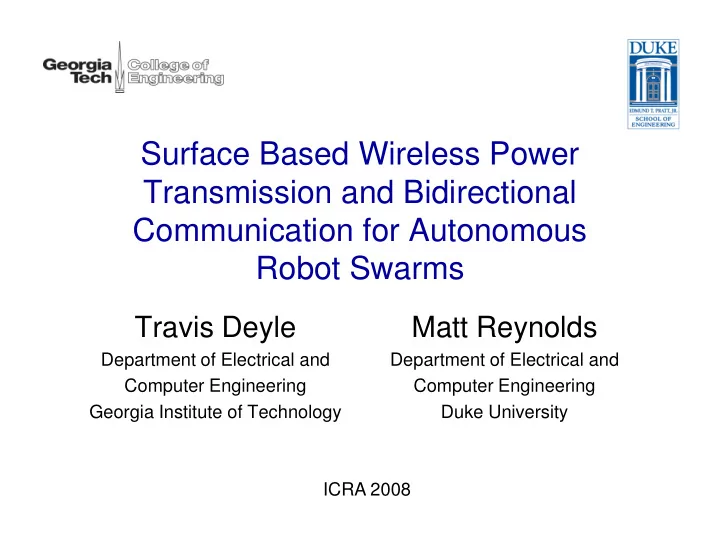

Surface Based Wireless Power Transmission and Bidirectional Communication for Autonomous Robot Swarms Robot Swarms Travis Deyle Matt Reynolds Department of Electrical and Department of Electrical and Computer Engineering Computer Engineering Georgia Institute of Technology Duke University ICRA 2008
Overview • The Swarm Power Problem • Related Power Distribution Approaches • Other Wireless Power Systems • Proposed Power Surface Design • Proposed Power Surface Design • Proposed Power Surface Characterization • Conclusions
The Problem Powering a Swarm of Robots • Different activity levels = different power consumption • Primary cell batteries are environmentally unfriendly • How to maintain rechargeable batteries? Solution: Get rid of batteries. Provide continuous Solution: Get rid of batteries. Provide continuous wireless power to the swarm from its operating surface. Image Credit: Axelrod, Georgia Tech Image Credit: Caprari, EPFL Switzerland Image Credit: McLurkin, MIT
Potential Solutions • Onboard Power: – Batteries • Exchange Behaviors • Docking Behaviors – Alternative Sources • Hydrocarbon Fuels • Fuel Cells Image Credit: Roomba from iRobot.com • Biomass Fuels • Offboard Power – Tethers – Solar, Fields, Kinetic Image Credit: Caprari, EPFL Switzerland
Proposed Solution Wireless, battery-less power (Robots are RFID tags with wheels & sensors) Ampere’s Law (coil): Ampere’s Law (coil): Faraday’s Law:
Related Work Other Inductive Wireless Power Systems Image Credit: Gao, Fraunhofer IBMT Image Credit: Sekitani et al, University of Tokyo Multiple magnetic induction coils Multiple magnetic induction coils • Mechanically complex • Mechanically complex • Complex control scheme • MEMS and organic FETs • Can provide localization info • Complex control scheme • Not easily tile-able • Can provide localization info • Tile-able
Related Work Nano-robots powered by fields NIST Image Credit: Craig McGray • Surface fields cause actuation of nano-actuator • No logic or memory in the robot • Better considered “distributed actuator”
System Design • 112KHz operating frequency • Single resonant transmitter coil in power surface • Non-resonant receiving coil on each robot • Magnetic flux coupling between transmitting and receiving coils • Surface to robot coupling virtually unaffected by number of robots • Mechanically and electrically simple • Supports bidirectional communication • Does not support localization
Resonance Considered Advantage of Resonant Coils: High Q increases circulating current in transmitting coil for given drive voltage- yields higher induced voltage in robot Disadvantages of Resonant Coils: High Q coils present manufacturing problems Coupled resonant coils interact and de-tune each other High Q resonances limit available bandwidth for communication Tradeoff: Use resonant transmitting coil under surface Robots use non-resonant receiving coils Robots interact with surface resonance, but not each other
Power Surface Design Primary C L=740uH C=2.7nF Resonant F=112KHz Secondary Schematic Underside of Prototype (0.6m x 0.6m)
Robot Power Design Logic Power High Priority Motor Power Lower Priority Communications & Power Conditioning Schematic Board
Robot Prototype Line-Following Application ESCAP PIC microcontroller DC gearmotors IR Comm. Coil IR line sensor array
Communication Surface-to-Robot • 100% AM modulation • Data rate 800bps, limited by coil Q of 125
Communication Surface-to-Robot at 800 bps Coil resonance limits rise time / data rate Surface Field Amplitude-Modulated Amplitude-Modulated Robot Filtered RX Robot RX Data
Communication Robot-to-Surface • Load modulation by FET switch • Data rate 20Kbps, 1% modulation depth
Communication Robot-to-Surface at 20 kbps Robot TX Data Surface DEMOD input Surface DEMOD output
Power Density Measured Power (Watts) into simulated robot load (80 � ) at various heights above surface 0 cm (on surface) 5 cm above surface � > 4.1mW/cm 2 average
Power Density Measured Power (Watts) into simulated robot load (80 � ) at various heights above surface 10 cm above surface 15 cm above surface
Robot-Robot Interaction Non-Resonant Coils on Robots Non-overlapping = little interaction Overlapping coils interact Virtually no interaction between robot coils until they’re atop each other
System Efficiency n ⋅ 200 mW η system ≈ 12 W + n ⋅ 200 mW ⋅ η coupling Small when robot coils are small compared to surface • Surface quiescent draw is 12W to overcome losses in transmitting coil. • Each robot recovers ~200mW • Efficiency increases with # of robots
Summary Benefits: – Simple, Low Cost Construction – Persistent Power to Large Number of Robots – Bidirectional Communication – Enabling Technology for Swarm Research Future Work: – Characterize Efficiency with Larger Number of Robots – Improve Communication Bandwidth – Develop Tiling Scheme – Web Community for Interested Researchers
Questions? Travis Deyle Matt Reynolds Georgia Institute of Tech. Duke University tdeyle@gatech.edu matt.reynolds@duke.edu
Recommend
More recommend